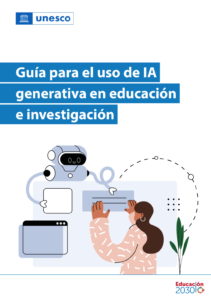Thirty years ago, writing a 2,000-word essay on, for example, the causes, development, and consequences of World War II, the suffragist movement, or the Renaissance and its influence, involved at least a few hours of research and many more of writing. Today, in just 40 seconds, an AI application generates a text on any of these topics, using natural language.
Can we fight against it? The answer is no. Nor should we. According to a survey by the Observatory of Technology Impacts on Professions, prepared by Alfonso X el Sabio University, in which more than 2,000 students and nearly 400 professors participated, three out of four university students under the age of 25 use generative AI to search for information, solve doubts, and generate content. So, perhaps the right question is: how can we incorporate this tool into education in the most effective and safe way?
 Generative artificial intelligence has entered classrooms and research with force. Since the emergence of tools like ChatGPT at the end of 2022, the possibilities it has opened for education are infinite. However, although these new technologies promise to automate tasks, personalize learning, and generate content, they also bring ethical challenges and concerns about their long-term impact. In this article, we explore the benefits and risks of generative AI with the help of UNESCO and its Guide for the Use of Generative AI in Education and Research. What is it? How can we use it to improve education while minimizing its risks? Let’s find out.
Generative artificial intelligence has entered classrooms and research with force. Since the emergence of tools like ChatGPT at the end of 2022, the possibilities it has opened for education are infinite. However, although these new technologies promise to automate tasks, personalize learning, and generate content, they also bring ethical challenges and concerns about their long-term impact. In this article, we explore the benefits and risks of generative AI with the help of UNESCO and its Guide for the Use of Generative AI in Education and Research. What is it? How can we use it to improve education while minimizing its risks? Let’s find out.
What is Generative AI?
Generative artificial intelligence refers to a technology that, instead of simply replicating existing information, has the ability to create new content. By using advanced language models like GPT (Generative Pre-trained Transformers), this technology can generate texts, images, music, videos, and more, from simple instructions (also called prompts) provided by the user.
For example, when using a tool like ChatGPT, you just need to write a command or a question, and the AI generates a response, which can be a complete text or even a creative solution to a problem. These tools have incredible applications in education, allowing the generation of study materials, drafting reports, or even acting as personalized tutors for students.
Generative AI tools are based on advanced artificial neural network models that emulate how the human brain processes and generates information. These networks are trained with large volumes of data taken from the internet, books, and other sources. Through this training, AI learns patterns and linguistic structures that allow it to create coherent and relevant responses.
However, as UNESCO’s report highlights, generative AI does not understand the real world. Although it can produce texts and responses, it does not possess a true understanding of the concepts it handles. This means that it can make mistakes or inaccuracies that may go unnoticed if users are not experts in the subject.
The potential impact of this artificial intelligence on education is enormous. As we have already mentioned, generative AI allows teachers to create exams, assignments, or even complete lessons in a matter of minutes, and for students, personalized tutoring, adapting explanations and exercises to individual needs.
However, as we will see later, this potential comes with ethical challenges, which must be addressed to ensure responsible use of these technologies.
AI is here to stay. Banning it is not an option. Looking the other way is not an option either. This UNESCO publication provides valuable guidance for governments, educational institutions, and AI providers on how to implement these technologies responsibly and ethically.
How Can Generative artificial inteligence Help the Educational Community?
UNESCO’s guide outlines some of the main benefits that adopting generative AI in education can bring.
- Task automation and workload reduction. One of the immediate benefits is the automation of repetitive tasks, such as grading exercises, preparing tests, and generating educational materials. This frees teachers from administrative tasks and allows them to focus on teaching and providing individual support to students.
- Personalized learning. Generative AI allows content to be tailored to the specific needs of each student. This is especially relevant in an environment where students have different learning speeds, styles, and abilities. Through AI, personalized explanations or additional exercises can be generated to reinforce the areas where each student needs more support.
- Personalized tutoring. In self-directed learning environments, AI can act as a virtual tutor, providing feedback and guidance as students progress. This personalization has the potential to close educational gaps and offer more effective support, especially in groups of students with special needs.
- Research and knowledge generation. In addition to its use in teaching, generative AI also has great potential in research. Researchers can use it to analyze large volumes of data, generate preliminary reports, or even write drafts of scientific articles. By freeing researchers from routine tasks, AI allows them to focus on critical analysis and interpretation of results.
Ethical Challenges and Risks of Generative artificial inteligence
While generative AI offers exciting opportunities, it also raises important ethical challenges that must be addressed for its safe and effective implementation in education. UNESCO’s report identifies several of these risks, ranging from data privacy to bias in generated content.
- Privacy and data protection. One of the main problems with generative AI is the massive collection of personal data. AI tools are trained using large amounts of information, and in many cases, this information may include sensitive personal data. This raises concerns about the privacy of students and teachers who use these tools, especially in educational contexts where data protection must be a priority.
- Copyright and content usage. Another worrying aspect is the use of copyright-protected materials. Generative AI tools are trained using a variety of sources, many of which are protected by intellectual property laws. This raises questions about the originality of the content created by AI and who holds the rights to the generated material.
- Bias and inequality in generated content. Generative AI models can replicate and amplify the biases present in the data they have been trained on. This is especially problematic in education, where equity and inclusion are essential. If AI models are trained with biased data, they could generate content that perpetuates stereotypes or marginalizes certain groups.
- Manipulation and misinformation. The ability of generative AI to create realistic content poses an additional risk: the creation and dissemination of misinformation. In the educational context, the accuracy of information is crucial, and the use of AI to generate false or misleading content could have serious consequences.
Regulation and Policies for Ethical Use of Generative AI
Given the rapid advancement of generative AI, it is essential that clear regulations and policies are established to ensure the ethical and safe use of these technologies. UNESCO offers a series of key recommendations for governments, educational institutions, and technology providers.
Protection of privacy and data. As already mentioned, one of the main challenges in the use of generative AI is the protection of the privacy of students and teachers. AI tools require large volumes of data to function, raising concerns about how personal information is handled and the possibility of its misuse. To address this issue, it is crucial that governments establish strict data protection policies.
For their part, educational institutions must ensure that any generative AI tool they use complies with current privacy regulations, such as the General Data Protection Regulation (GDPR) in the European Union. This includes informing users about how their data is collected and used and ensuring that students have control over the information they share. Likewise, students and families should be allowed to opt out of systems that collect sensitive data if they wish.
Transparency and accountability of providers. Generative AI tool providers play a key role in creating safe and ethical systems. They should be required to be transparent about the data they use to train their models, as well as how user data is processed. Additionally, independent audits are necessary to ensure that these tools do not perpetuate bias or discrimination in the content they generate.
Moreover, providers should develop mechanisms to detect and correct potential biases in generative AI models. These systems must be trained with diverse and representative data to avoid perpetuating stereotypes or excluding certain groups. Cultural and linguistic diversity should be a central principle in the development of these models.
Age limits and supervised use. Since generative AI can have a significant impact on students’ development, it is necessary to set age limits for its use. UNESCO recommends considering supervised use for younger students and developing regulations to ensure that these tools are not used inappropriately, such as for cheating on exams or assignments.
Schools and universities should create clear policies on when and how these tools can be used in the educational environment. This does not necessarily mean banning them, but rather integrating them responsibly and ethically, ensuring they are used as a complement to learning and not as a substitute for academic effort.
Continuous monitoring and evaluation. Finally, it is essential that governments and educational institutions implement continuous monitoring and evaluation systems to ensure that the use of generative AI in education aligns with ethical and pedagogical principles. This involves conducting periodic reviews of AI systems and tools, as well as usage policies, to adapt to technological advances and the new challenges that may arise.
The impact of generative AI on education is still in its early stages, but its long-term potential is immense. However, as UNESCO’s guide warns, it is important for education systems to prepare for the ethical and regulatory challenges that accompany these technologies. The future of education with generative AI must be based on a human-centered approach, respecting diversity, promoting inclusion, and ensuring equity in access to these tools.
AI is here to stay. Banning it is not an option. Looking the other way is not an option either. This UNESCO publication provides valuable guidance for governments, educational institutions, and AI providers on how to implement these technologies responsibly and ethically. With proper regulation and careful planning, generative AI can be a powerful tool that benefits teachers, students, and researchers worldwide.






